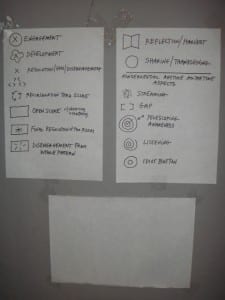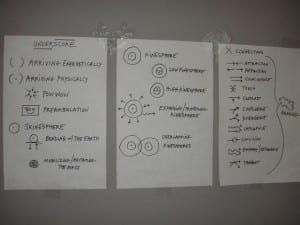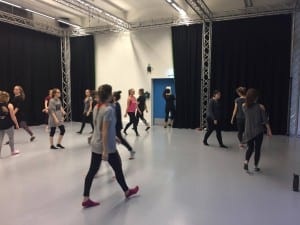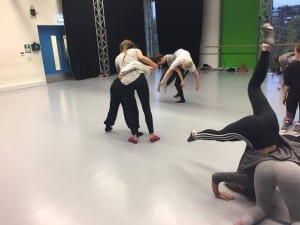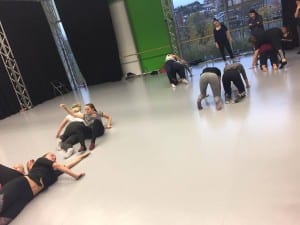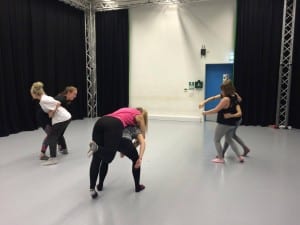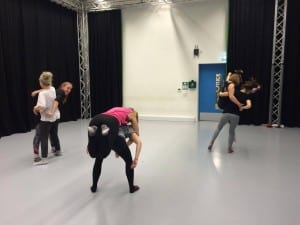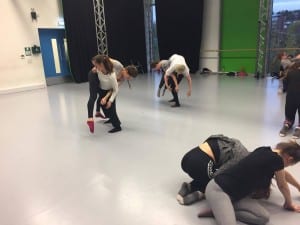Contact improvisation has challenged me to push myself beyond any of my expectations, this module has given me a real perspective on how much my body can do and how oblivious I was too the movement within my body.
The challenges I have encountered throughout this module have really made me reflect on my previous dance experiences, release technique came very foreign to my body, and its something I’ve noticed has been embodied within my body within the past 4 weeks. As soon as the release technique started to embody within my body, I noticed how much my connection between other bodies have improved creating momentum and ‘risker’ movements for myself and between me and another body, no longer having the ‘fear’ of contact improvisation.
It took me a couple of weeks to really draw my body back to the basics of improvisation, things that we had learnt during first year and for a couple of weeks I noticed that a lot of my improvisation and contact improvisation was reverting back to habitual movements, I started to notice that I focusing less on creating new and exciting movement and more focusing on the legitimates of it, for example keeping the connection, allowing my body to release and using my breath to ensure this.
Giving to receiving was something that is constantly on mind throughout the whole contact module, ensuring I offered as many platforms for each of the bodies I worked with as possible. This is something I struggled to work with, if my partner wouldn’t offer a platform I would tend to offer as much as I could and then move out of the jam. This is something I brought my attention to and thought more about within the jam’s, working with people I had never worked with before to really challenge my contact improvisation skills. I noticed this during this week’s session, as I started to work with a body I had never made contact with throughout the whole of the contact module and I was surprised to see how much interesting and creative material we managed to create.
Whilst working within scores, especially Nancy stark smiths the underscore, I started to realise how important it was to enter the space energetically, physically and mentally. (Koteen and Stark Smith, 2008).
I never realised how important this was until I started to apply this to other modules such as technique classes. This really helped me to forget about any issues that I had outside of class and helped me to bring my mind into what I was about to do and how to push my body as far as I possibly could, it also helped to put my all into the module every lesson. Being present within the space also helped to me scan through my body to find any points of tension and to warm up within the respective areas that need more attention that other parts of my body. For example, with damaged tendons within my right shoulder, it was really important for me to release all the pressure from shoulder and warm up it probably to ensure that no more damage would happen from the session.
“Take an image, let it hang in the mind, let the sensation of the thought dissolve through the body. Let the movement inside of the body- of the breath, of thoughts – move the outside. Allow the sensations their own time and expression – yawning, rolling, resting – waiting for a space between the thoughts, an unlocking of the parts of the body – a gap into which something new can emerge” (Tufnell and Crickmay, 1993)
Researching into Paxton’s small dance theory, it really brought my attention to the reflex’s within the body and how movement can stem from each of the reflex’s. I rewatched Paxton’s small dance video again to reflect on my practice and how far i had come from week 4 and i started to realise that even though i struggled to ignore the reflex’s and keep myself from fidgeting, i noticed that i used the reflexes i saw in Paxton’s video in my own body to explore movement through my reflexes. Through thinking of Paxton’s small dance idea, I started to think about skinasphere, when we first explored this during class it was something I didn’t quite understand, I didn’t understand how you was supposed to explore it and I started to become very habitual with it, only using my hands and arms to explore this. However, when we revisited it during the underscore, it started to become clear and I started to explore skinasphere with body parts such as my hips, pelvis and head, making a connection to the other person’s body, for example hip to knee and head to shoulder. I managed to create different movements which explore all the kineaspheres.
Contact improvisation has really bad me think about the connections in my body and the connections to other people’s bodies, for example it’s really made me think about the internal link within my body and the different ‘Jigsaw puzzle’s’ platform’s between two bodies. I have learnt so much about different bodies that I never realised before, including ‘going down to go up’ and ‘anchoring and levering’, I realised that no matter the height and difference, through contact improvisation as long as the right connections are made anybody can lift anybody.
Reflecting on my practice through the contact module I have notice how much I have progressed, how my movement has become grounded and how that has created more fluidity through my movements. I have found different ways of expressing myself through dance, including twisting, pushing, turning and pushing my body to do things I wouldn’t normally feel comfortable doing. I have noticed I have more room to grow within my body and contact improvisation, to create more release through my body and to think more about the internal connections through my body. I have also noticed that my confidence has grown and I no longer panic on what people are thinking about me, this has created a new spark within myself to really explore my movement as much as I can, I have started to close my eyes whilst doing this, which has helped me think more internally about my movement.
The skills I have learnt through contact improvisation will stay with me for the rest of my dance career, and it’s something I would like to explore further within my career. I have gained a new confidence within myself and my movement and that’s something that has effect me through all my modules this semester.
Bibliography
Tufnell, M. and Crickmay, C. (1993) Body Space Image. Cornwall: MPG Books Ltd.
Koteen, D and Stark smith, N. (2008) Caught Falling: The confluence of contact improvisation, Nancy stark Smith, and other moving ideas. USA.
Paxton, S. (2009) Small Dance. Available from:https://www.youtube.com/watch?v=6sJKEXUtv44 (Accessed 10 Dec 2016)
